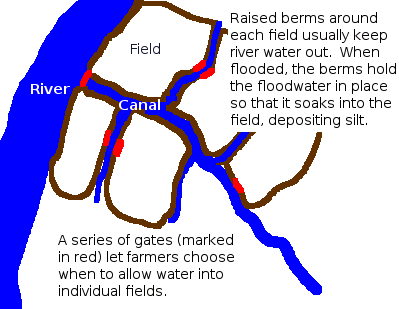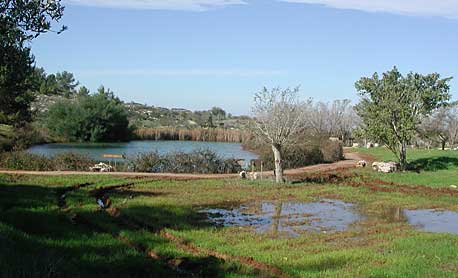
Mexican silting fields
 While Guatemala is full of methods of adding
plant matter to farm fields, it seems like Mexicans spend more energy
on harvesting sediment out of water. In the Tehuacan Valley of
southwest Mexico, elaborate systems of canals and dams are used to
apply just the right amount of top quality silt to fields.
While Guatemala is full of methods of adding
plant matter to farm fields, it seems like Mexicans spend more energy
on harvesting sediment out of water. In the Tehuacan Valley of
southwest Mexico, elaborate systems of canals and dams are used to
apply just the right amount of top quality silt to fields.
Neighboring farmers all work together to build the infrastructure
required to channel water from rivers to nearby farms. Each
farmer builds retaining walls around his fields out of soil, then
decides when to open gates and allow flood water to flow from the
canals into his fields. Silt settles out as the water sinks into
the ground and the result is about half an inch of high fertility
topsoil per flood.
 Farmers have about a dozen
floods a year to choose from, and most opt to open their flood gates
for just three or four. Since storms in the region
are often spotty, silt quality varies widely from flood to flood.
Floods fueled by storms in a certain part of the watershed will wash
high quality topsoil into the river while storms in another region
result in lower quality silt. Experienced farmers are able to
tell the difference and pick the right floods to feed their
fields. Even when floods contain high quality silt, farmers
usually let the first flush of water flow past unharvested since it
tends to contain trash and dead animals they don't want on their fields.
Farmers have about a dozen
floods a year to choose from, and most opt to open their flood gates
for just three or four. Since storms in the region
are often spotty, silt quality varies widely from flood to flood.
Floods fueled by storms in a certain part of the watershed will wash
high quality topsoil into the river while storms in another region
result in lower quality silt. Experienced farmers are able to
tell the difference and pick the right floods to feed their
fields. Even when floods contain high quality silt, farmers
usually let the first flush of water flow past unharvested since it
tends to contain trash and dead animals they don't want on their fields.
We actually saw a system like this at work in the Rio Grande Botanic
Garden several years ago (although the primary purpose there was
irrigation), and I've been intrigued ever since. Our creek floods
several times a year, but we just let the muddy water flow past,
untapped. Our current garden is up out of the floodplain and
wouldn't be eligible for silt harvesting, but this is certainly an idea
I'd like to keep on the back burner.
| This post is part of our Central American Permaculture lunchtime
series.
Read all of the entries: |
Want more in-depth information? Browse through our books.
Or explore more posts by date or by subject.
About us: Anna Hess and Mark Hamilton spent over a decade living self-sufficiently in the mountains of Virginia before moving north to start over from scratch in the foothills of Ohio. They've experimented with permaculture, no-till gardening, trailersteading, home-based microbusinesses and much more, writing about their adventures in both blogs and books.
Want to be notified when new comments are posted on this page? Click on the RSS button after you add a comment to subscribe to the comment feed, or simply check the box beside "email replies to me" while writing your comment.
